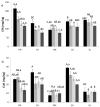Caftaric Acid Isolation from Unripe Grape: A "Green" Alternative for Hydroxycinnamic Acids Recovery
- PMID: 33669973
- PMCID: PMC7924824
- DOI: 10.3390/molecules26041148
Caftaric Acid Isolation from Unripe Grape: A "Green" Alternative for Hydroxycinnamic Acids Recovery
Abstract
Phenolic acids represent about one-third of the dietary phenols and are widespread in vegetable and fruits. Several plants belonging to both vegetables and medical herbs have been studied for their hydroxycinnamic acid content. Among them, Echinacea purpurea is preferentially used for caffeic acid-derivatives extraction. The wine industry is a source of by-products that are rich in phenolic compounds. This work demonstrates that unripe grape juice (verjuice) presents a simple high-pressure liquid chromatography (HPLC) profile for hydroxycinnamic acids (HCAs), with a great separation of the caffeic-derived acids and a low content of other phenolic compounds when compared to E. purpurea and other grape by-products. Here it is shown how this allows the recovery of pure hydroxycinnamic acids by a simple and fast method, fast protein liquid chromatography (FPLC). In addition, verjuice can be easily obtained by pressing grape berries and filtering, thus avoiding any extraction step as required for other vegetable sources. Overall, the proposed protocol could strongly reduce the engagement of solvent in industrial phenolic extraction.
Keywords: FPLC; caftaric acid; hydroxycinnamic acids; unripe grape juice; verjuice.
Conflict of interest statement
The authors declare no conflict of interest.
Figures




References
-
- Yuan Y., Jiang L. Application of Chicoric Acid Extract in Echinacea Purpurea. CN102726550. 2012 Oct 17;
-
- Marchiosi R., dos Santos W.D., Constantin R.P., de Lima R.B., Soares A.R., Finger-Teixeira A., Mota T.R., de Oliveira D.M., de Pavia Foletto-Felipe M., Abrahão J., et al. Biosynthesis and metabolic actions of simple phenolic acids in plants. Phytochem. Rev. 2020;19:865–906. doi: 10.1007/s11101-020-09689-2. - DOI
MeSH terms
Substances
LinkOut - more resources
Full Text Sources
Other Literature Sources

